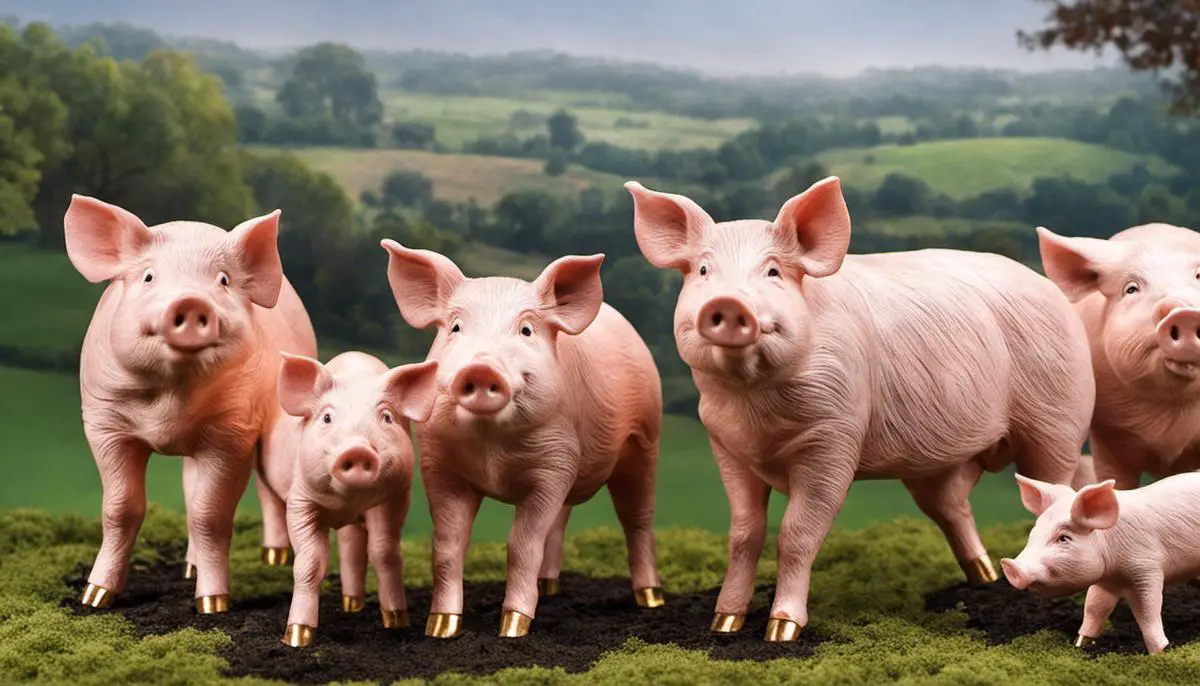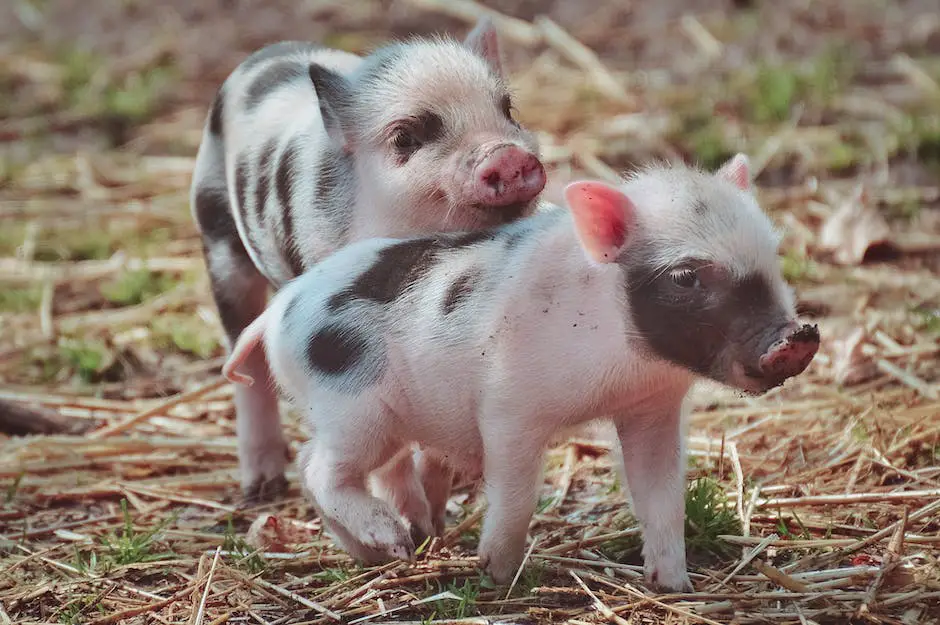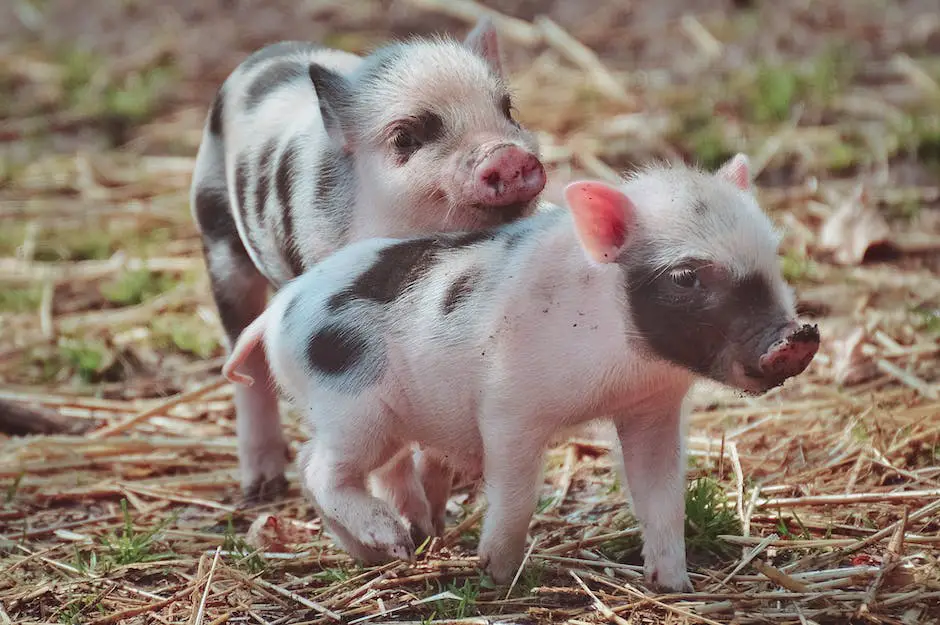The enigmatic world of dreams has sparked curiosity and inspired contemplation since antiquity. Vivid dreams featuring animals often carry symbolic significance, requiring thoughtful interpretation to unravel their meanings. Among such animals, the presence of piglets is particularly intriguing. Owing to their unique historical symbolism and cultural connotations, piglets in dreams can be open to a wide array of interpretations. This discourse delves into the multifaceted significance of piglets within dreams, exploring the historical context of pig symbolism, traversing psychological theories regarding dream interpretation of animals, interpreting various piglet-centered dream scenarios, evaluating the impact of personal and cultural perspectives, and finally, discussing the practical application of such dream interpretations in real life.
Historical Context of Pigs and Piglets in Symbolism
Pigs and Piglets: Symbolic Representations Across History
The symbolic depiction of animals, noteworthy in historical and cultural contexts, predates the neolithic era. These depictions are fascinating to dissect, but the focus here is the pig – an animal that has held an inexplicably compelling place in various societies, each with unique historical meaning.
Archeology reveals the pig’s immense significance in Neolithic societies. Archeologists discovered pig bones in massive amounts at ancient sites, indicating pigs were a vital source of food. However, the intrigue arises in the discovery of exquisitely carved pig figurines, foreshadowing the narrative of pigs as potent symbols. In the Neolithic Age, our predecessors revered wild boar for their vigour and ferocity, associating them with strength and ferocity.
Fast forward to Classical Greece, the pig was sanctuary to the goddess Demeter and held a primary role in her mythology. Here, it symbolizes fertility and agriculture, underscoring the pig’s economic and cultural significance in Greek society. Pigs additionally played an integral role in religious ceremonies and rites.
In ancient Chinese culture, the pig holds a rather auspicious significance. Regarded as a symbol of fortune, wealth, and prosperity, its importance is evident in the Chinese zodiac, where it occupies the twelfth position.
The dive into Biblical symbolism of pigs tells a starkly different tale. In both Judaism and Islam, the pig is considered ‘unclean’ due to specific dietary laws. In the Christian Bible, pigs harbor negative connotations, symbolizing greed, gluttony, and uncleanliness.
The Middle Ages fostered the negative stereotype, with pigs often used to represent sinful behavior. This perception only shifted during the 18th-century, Romanticism surge, with the pig was often illustrated as a subject of pastoral life, representing innocence and simplicity.
The Industrial Revolution initially devalued the pig’s symbolism, primarily seeing it as a food source. However, societal perception began shifting yet again as pigs became popular characters in literature and animation towards the late 20th century. For instance, the contemporary portrayal of piglets in animation often signifies innocence, naivety, and endearing charm.
From revered idols to vilified creatures, from symbols of wealth to depictions of innocence and charm, pigs and piglets’ continuous shift in symbolism over millennia offers a powerful indicator of society’s ever-changing values, attitudes, and beliefs.
An exploration of pigs from an art historical perspective further substantiates the dynamic symbolic value of these creatures in different socio-cultural contexts. Over the ages, artists painted pigs and piglets in their works to invoke various themes – fertility, luck, gluttony, innocence, and more recently, as symbols for corporate greed and consumerism.
The humble pig’s journey through history serves as a vivid tapestry of human culture and societal norms, demonstrating how even a simple animal can adopt such a myriad of meanings and interpretations within the incredible scope of human history. This intricate symbolism has piquely stirred the curiosity of scholars across different disciplines, fostering interdisciplinary research into the development and transformation of pig symbolism across human history.

Psychological Theories Regarding Animals in Dreams
Framing the cerebral stage onto the realm of dreams, our understanding of animals and their symbolic significance further broadens. Analyzing widely recognized psychological theories, the appearance of animals, particularly piglets, in dreams, can be examined and discerned, serving as conduits from subconscious contents to conscious understanding.
The iconic psychoanalyst Sigmund Freud asserted that dreams serve as the royal road to unconscious mind, where our latent desires and fears reside. In his seminal work ‘The Interpretation of Dreams’, Freud viewed animals in dreams as representations of instinctual drives or desires that have been repressed. The animal forms these suppressed urges take depend on various subjective and cultural aspects. Piglets, with their conventional associations of innocence and charm, may thus symbolize suppressed aspects of one’s innocence, naivety, or on the contrary, can denote some instinctual drive towards these traits, which the dreamer perceives to be unattainable or unacceptable in their waking life.
Moving from the father of psychoanalysis to his protegé, Carl Jung, an alternative reading of piglets in dreams presents itself. Differentiating from Freud’s emphasis on repression and latent desires, Jung’s interpretation of dreams gravitates towards the notion of collective unconscious, archetypes, and the process of individuation. Pigs and piglets, accumulating various socio-cultural imprints across history, can serve as vehicles of archetypes within our collective unconscious. Their appearance in dreams can be amidst the unfolding of individiation, the psychological process of integrating distinct elements of personality. Furthermore, considering their contemporary portrayal as innocent and naive beings, piglets may symbolize the ‘divine child’ archetype, representing one’s unrealized potential or a longing for spiritual rebirth.
Finally, turning to Gestalt psychology, founded by Fritz Perls, which views dreams as projections of the individual’s current state of being. Piglets, in this conceptual frame, do not serve as signifiers of repressed desires or collective unconscious but symbolize parts of the dreamer’s persona or experience that are asking to be recognized. If piglets are appearing in a dream, the dreamer might need to attend to facets of themselves or their experience that aligns with their subjective understanding of piglets, perhaps, traits of innocence, vulnerability, naivety.
Thus, from the lenses of Freudian, Jungian, and Gestalt psychology, the appearance of piglets carry a rich array of meanings rooted in the dreamer’s subconscious, socio-cultural imprints, and current state of being. It illuminates the ever-evolving, complex interplay between various levels of our mind and the world, unraveling the intricate tapestry of human psyche.

Interpreting Piglets in Dreams
Embarking further into the realms of the dream world and the subconscious mind, it seems worthy to consider the context-related interpretations of seeing a piglet in a dream from diverse philosophical, spiritual, and psychological perspectives. These reveal profound layers of connotations that run deeper than mere surface-level symbolism.
On a philosophical plane, referencing phenomenology, dreams involving piglets can be perceived as a means to engage with the ‘lived experience’ in a non-physical reality. Encountering a piglet in dreams suggests a vivid experience of something intangible, while connecting the dreamer with the primal nature or providing fresh interpretations of reality, much like the piglets exploring fresh terrains in nature.
To divide this abstract concept into small, manageable portions, the symbolism of piglets in dreams can be categorized into multiple themes. Primarily, in many spiritual and transcendental understandings, dreams are considered as symbolic messages from a higher consciousness. In this pantheon, piglets frequently denote abundance, good fortune, and fertility, influenced by the animal’s natural instincts of foraging, nurturing, and reproducing. Transferring these connotations to humans, they encapsulate the idea of material prosperity and the potential for growth within the dreamer’s life.
Among different Native American tribes, the piglet’s symbolism is extended to the realms of courage, determination, and resilience. Dreaming of a piglet in this context might signal perseverance in the face of adversity. It invites the dreamer to cultivate those skills and attitudes required to navigate difficult circumstances, promoting the mental fortification of the individual.
Psychological perspectives add another layer of complexity and depth to the symbolism of piglets in dreams. These sentient creatures, with their playful nature and spirited curiosity, can also signify suppressed joy and curiosity tied to childhood experiences or trauma in dream analysis. Here, one is confronted with the Jungian notion of Anima and Animus, the feminine and masculine traits within us. Drawing from the innocence and vivaciousness of a piglet, it could be a representation of suppressed child-like qualities, or calling attention to the less nurtured aspects of our persona.
There are countless other interpretations which continue to unravel fascinating links between culture, biology, and personal sentiments, contributing to the magnificent tapestry of piglet symbolism in dreams. With each interpretation feeding into a distinct narrative, it becomes evident that the piglet’s appearance in dreams could mean significantly different things, largely dependent on individual circumstances and cultural contexts.
What becomes indisputable, however, is the potent symbolism inherent in the humble piglet – an emblem carved out of millions of years of biological tendencies, cultural constructs, and complex mental processes. These understandings only further magnify the significance of this animal, elevating it from mere livestock to a powerful motif in dreams, steeped in untold symbolic potential.
As science surges forward, opening new avenues for understanding the human consciousness and the world at large, the symbolic resonance of the piglet stands as a testament to what still remains elusive, intricate, and deeply personal – the human subconscious mind.

Impact of Personal and Cultural Factors
Building on these pivotal grounds, it is crucial to delve deeper into the influence of individual characteristics on one’s interpretation of piglets in dreams, particularly considering personal beliefs and cultural background. These individualistic components shape not only our perception of physical reality but also the constructs of the dream world.
In some cases, personal beliefs influence the interpretation of dream symbols, exclusive of the influence of cultural background. For instance, an individual who associates piglets with happiness due to a pleasant childhood memory of a piglet pet may interpret the symbol as a representation of joy and peace. The influence of personal beliefs, as such, is starkly evident in the dynamic and varied sense of individual interpretations.
The cultural context enmeshes deeply into personal beliefs and interpretations. The cultural background, in essence, forms an interpretative framework in comprehending the symbolism of piglets in dreams. For example, despite the international appreciation of piglets as symbolic of prosperity and good fortune, in various African cultures, dreams about pigs often connote issues related to selfishness or overindulgence. Hence, individual’s cultural affiliation can distinctly affect the perception and interpretation of the piglet symbolism in dreams.
As we unravel the facets of dream interpretation, it is noteworthy to mention that interpreting dream symbols extends beyond the confines of the symbolic representation of an animal or object. The context of the dream, the interaction with the dream symbol, the emotions evoked in the dream, all play significant roles in shaping the interpretation. Consequently, the interpretation involves a cognitive connectivity of abstract symbolism with the conscious state of mind.
One can draw concrete connections to the influences that cognitive science and neurobiology exert on dream interpretation too. Interpretation of dream symbols, such as piglets, can hinge on the interplay between neural mechanisms underlying memory consolidation during sleep and the emotional relevance that the dreamer attaches to the dream symbol.
In conclusion, the interpretation of dream symbols, like piglets, can be a multifaceted process, influenced by a panoply of factors including personal beliefs, cultural underpinnings, and even biological predeterminants. While comprehensive understanding remains elusive, the interpretive endeavor contributes significantly to enhancing our understanding of the human psyche, the vast landscapes of our subconscious, and perhaps, our shared humanity. It posits a fascinating juncture of science, art, spirituality, and philosophy.

Practical Application of Dream Interpretation
Delving into the realm of individual characteristics and their influence on dream interpretation, it is imperative to remember that each person’s personal history and experiences add a unique lens through which they view and interpret their dreams. Just as pigs and piglets hold different symbolic representations across various cultures and time periods in waking life, the manifestation of these creatures within dreams is as distinctly individualistic as the dreamer themselves. A personal history enriched by positive experiences with pigs, for instance, could imbue the dream piglet with more auspicious connotations than one whose childhood was overshadowed by porcine misconceptions.
The influence of personal beliefs on interpreting dream symbols cannot be overstated. Our beliefs serve as frames of reference for handling and processing information. They ground us. They lend context, influencing how we interpret experiences, both in our waking lives and our dreamscapes. The piglet consequently could assume a multitude of identities based on the dreamer’s belief system.
While personal experiences and beliefs contribute to dream interpretation, one cannot discard the influence of the broader cultural milieu. The cultural context of dream interpretation plays a prominent role in deciphering the symbolic language employed within dreams. Dream symbols are seldom sterile – they are imbued with the traditions, myths, and narratives inherent to a cultural framework. Hence, a piglet’s symbolism within a dream may mirror its symbolic connotations embedded in the dreamer’s sociocultural context.
However, factors beyond symbolic representation indeed contribute to dream interpretation. The complex interplay between cognitive science, neurobiology, and dream interpretation warrants discussion. Recent neuropsychological research suggests dreams disclose the neurocognitive architecture’s intricacies, shaping theories of mind and perception. Pigs within dreams, then, might be subconscious echoes of cognitive processing patterns or synaptic integrations within the brain.
This emphasis on the multifaceted nature of dream symbolism illustrates the nuanced process of interpreting dream symbols. The intermingling of cultural symbolism, personal belief systems, individual experiences, and cognitive processing opens a Pandora’s box of potential interpretations.
Moreover, as our understanding of the human brain and cognition expands, the prospect of dreams providing a window into comprehending the human psyche, subconscious, and shared humanity grows more compelling. Might an abundance of piglets prancing about in one’s dreams symbolize a yearning for a simpler, more instinctual existence? Does a solitary, forlorn piglet evince a deep-seated sentiment of loneliness or loss? Can a family of pigs in dreams underscore a subliminal focus on family values or community bonds? The interpretive potential is abundant, underscoring the continually evolving framework of dream interpretation.
This exposé into the multifaceted interpretations of pigs and piglets in dreams, far removed from being comprehensive, seeks to ignite curiosity and inspire a new appreciation for our subconscious’ complexity. The symbolic value of pigs, tethered to our cultural histories, personal experiences, and neurocognitive processes, offers an enriching backdrop to exploring our dreams’ depth and breadth. As dream narratives unfold nightly on the subconscious stage, they invite us to delve deeper, ponder more, and understand better the beautiful conundrums that constitute the human experience.

Though dreams may be a realm of mystery and uncertainty, the act of interpreting their symbols, such as piglets, can serve as a profound vehicle for self-realization and personal evolution. Every piglet that frolics, squeals, or rests silently in our dreams is a reflection of our subconscious, possibly conveying hidden sentiments and unexplored aspects of our persona. The symbology of pigs and piglets, rooted in an ancient past and viewed through the lens of personal and cultural prisms, shape this dream narrative. Just as a mirror reveals our physical appearance, the interpretation of dreams can reveal our mental and emotional landscape, bringing our hopes, desires, fears, and challenges into clearer view. Hence, the exploration of piglets in dreams is not just an intellectual exercise, but a journey of self-discovery and growth, adroitly bridging the realm of sleep and wakeful consciousness.
